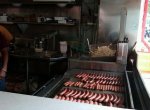Baltimore has crab cakes. Chicago has Deep Dish Pizza. And whether you prefer Pat’s or Geno’s, Philadelphia has the Philly Cheesesteak. Here in D.C. we have the half-smoke – a half beef, half pork coarsely-ground sausage that is smoked before it’s grilled. But in D.C., when it comes to this city’s signature food, there is no rivalry or controversy. The best place to get a half-smoke is the original Ben’s Chili Bowl.
All week I have had a craving for a half-smoke, split and grilled, and served on a warm steamed bun with onions and Ben’s spicy homemade chili sauce, and a side of onion rings and a Cherry Coke. So to end the week, on today’s bike ride I rode to Ben’s Chili Bowl for lunch.
As I was leaving after my delicious and satisfying lunch, I stopped and spent some time taking in the mural in the alley on the east side of the restaurant’s building. Over the years the various murals that have graced the west side of the building, in the alley officially recognized by the city as “Ben Ali Way,” have gotten considerable attention from the press. But the other, less-famous mural, is equally intriguing to me. It is dedicated to the owners and founders of Ben’s Chili Bowl – Ben and Virginia Ali. So I decided to find out more about the couple who founded the restaurant where I have eaten so many times.
Mahaboob Ali, commonly known Ben here in D.C., was born on June 13, 1927, in British Trinidad and Tobago. He was the firstborn of seven children in a Muslim family, and was raised in the town of San Juan, which is located east of the capital city of Port of Spain. Ben moved to the United States in 1945 as a student, where he enrolled at the University of Nebraska. At that time he was planning on becoming a medical doctor. But as the result of a fall down an elevator shaft while at the school he suffered a broken back. He spent months recovering from the accident. Following his recovery, Ben attended four separate schools before earning his bachelor’s degree from Howard University here in D.C.
Virginia Ali grew up on a farm in rural Virginia and moved to D.C. looking for a job and new opportunities in the big city. She went to work for one of D.C.’s heralded institutions — as a teller at Industrial Bank, the first African-American-owned bank in D.C. It was at the bank that she met Ben, the man with whom she fell in love, married, and became lifelong business partners with.
In 1958, newlyweds Ben and Virginia began renovating the building at 1213 U Street. Built in 1910, the building first housed a silent movie house called the Minnehaha Theater. Later, Harry Beckley, one of D.C.’s first black police detectives, converted it into a pool hall. The Ali’s simply wanted to own a business that would give them the means to raise their children. Ben had worked at a restaurant in college, and they decided to open up their own. They had no idea it would become such a huge success. Today, Ben’s has spawned locations all over the local area. It employs approximately 170 people and has about $8 million in revenue.
Ben passed away in October of 2009 at the age of 82. Virginia, who was only 24 years old when she and her husband started the restaurant, is now 85, and can still be found working at the U Street location most days – greeting customers and keeping tabs on the business that is now run be her family. Her three sons Kamal, Nizam and Haidar as well as her two daughters-in-law now run the day-to-day operations.
In August Ben’s will celebrate it’s 61st anniversary. Over those years people have changed. I certainly have. The restaurant, however, has not. The counter, booths and stools are all original. And the half-smokes are just as delicious as they’ve always been. Since the first time I ate there decades ago, I’ve known how good the food is. And now, I know a little more about the people too.
[Click on the photos to view the full-size versions]
Trivia Fact: Due to Islamic prohibitions against consuming pork, Ben Ali never consumed some of his own restaurant’s popular offerings.
































